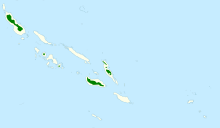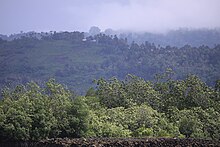
The fork-tailed palm swift or Neotropical palm swift is a species of bird in subfamily Apodinae of the swift family Apodidae. It is found across most of northern South America and on Trinidad and Tobago.

The pale-vented pigeon is a large pigeon found in the tropical Americas. Formerly often placed in Columba, it actually belongs to a clade of the older New World genus Patagioenas. With its relatives it represents an evolutionary radiation extending through most of the warm-temperate to tropical Americas. Grey-hued birds, even their males generally lack iridescent display plumage, although the present species has some coppery gloss on the nape.

The Choiseul pigeon is an extinct species of bird in the pigeon and dove family, Columbidae. It was endemic to the island of Choiseul in the Solomon Islands, although there are unsubstantiated reports that it may once have lived on several nearby islands. The last confirmed sighting was in 1904. Other common names were Solomons crested pigeon, Solomon Islands crowned-pigeon and Kuvojo.
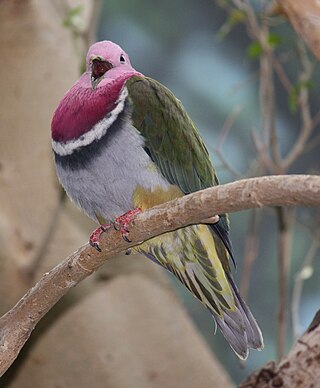
The pink-headed fruit dove also known as pink-necked fruit dove or Temminck's fruit pigeon, is a small colourful dove.

Wallace's fruit dove is a species of bird in the pigeon family Columbidae. The name commemorates the British naturalist Alfred Russel Wallace. It is a rather large, long-tailed fruit dove with a length of 24–28 cm (9.4–11.0 in) and has been described as "one of the most beautiful" fruit doves. The forehead and crown are dull crimson, the lower face and throat are white, and the rest of the head, breast, neck, and upper back are pale bluish-grey. The wings and lower back are green and the belly is orange, separated from the chest by a white band. Both sexes look similar, but females have less extensive red on the head and a greenish tinge to their grey parts.
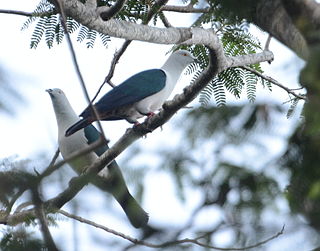
The elegant imperial pigeon, also known as blue-tailed imperial-pigeon, is a large pigeon, with upperparts mainly dark blue-green in colour with an iridescent sheen. Head, neck and underparts are mostly pale grey, with red-brown undertail coverts.

The pale-capped pigeon, also known as the purple wood pigeon, is a species of large pigeon that is found patchily distributed in parts of the Indian subcontinent and Southeast Asia. It has a slow flight and spends a lot of time sitting still in the foliage of large fruiting trees, often in riverine forest on the plains. It is mainly brown above and chestnut below with the a sheen of green or amethyst. Males have a whitish grey cap while females have a brownish grey cap and less gloss on the feathers. They are frugivores, foraging in small groups in the canopy of trees but sometimes descending to the ground for seeds and fallen fruit.

The snow pigeon is a species of bird in the genus Columba in the family Columbidae from hilly regions of central Asia. They are grey, black, pale brown and white birds and two subspecies are recognised: C. l. leuconota occurs in the western Himalayas from western Afghanistan to Sikkim and C. l. gradaria occurs in the mountains of eastern Tibet and from eastern Nan Shan (Qinghai) to Yunnan and extreme northern Myanmar. The birds forage in open country in pairs or small groups, feeding on grain, buds, shoots, berries and seeds. They roost at night on cliffs, breeding in crevices where they build untidy stick nests and lay a clutch of usually two white eggs. The International Union for Conservation of Nature has rated the bird's conservation status as being of least concern.

The mountain imperial pigeon, also known as the maroon-backed imperial pigeon or Hodgson's imperial pigeon, is a species of bird in the pigeon and dove family with a wide range in southeastern Asia.

The white-bellied imperial pigeon is a species of bird in the pigeon family Columbidae. First described by the French ornithologist Charles Lucien Bonaparte in 1854, it is endemic to Indonesia, where it is found on Sulawesi, Buton, Taliabu, Togian, and Peleng. It inhabits primary forest, dense secondary forest, and isolated areas of hill forest. A large pigeon with a long tail, it measures 42.5–51.5 cm (16.7–20.3 in) long and weighs 510 g (18 oz) on average. Males are mainly green, with pale-grey heads and bellies, chestnut vents, and a pale grey tail band, along with a red orbital ring. Females are nearly identical, but have darker grey areas in their plumage.
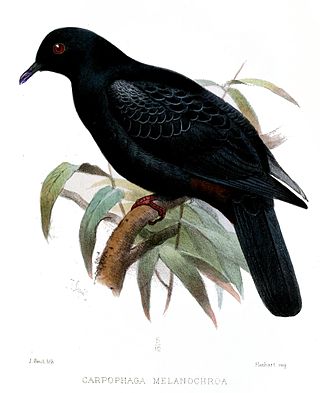
The black imperial pigeon, also known as the Bismarck imperial pigeon, is a species of bird in the family Columbidae. It is endemic to the Bismarck Archipelago where it lives in forests.

The island imperial pigeon is a species of bird in the family Columbidae. It is found in the Bismarck Archipelago and the Solomon Islands archipelago, living in primary and secondary forests and mangroves. The International Union for Conservation of Nature (IUCN) has assessed it as a least-concern species.
The grey-headed imperial pigeon is a species of bird in the family Columbidae. It is endemic to Sulawesi in Indonesia. Its natural habitats are subtropical or tropical moist lowland forests and subtropical or tropical moist montane forests.

The Papuan mountain pigeon is a species of bird in the pigeon family, Columbidae. It is found in the Bacan Islands, New Guinea, the D'Entrecasteaux Islands, and the Bismarck Archipelago, where it inhabits primary forest, montane forest, and lowlands. It is a medium-sized species of pigeon, being 33–36 cm (13–14 in) long and weighing 259 g (9.1 oz) on average. Adult males have slate-grey upperparts, chestnut-maroon throats and bellies, whitish breasts, and a pale grey terminal tail band. The lores and orbital region are bright red. Females are similar, but have grayish breasts and grey edges to the throat feathers.

Mountain pigeons are four species of birds in the genus Gymnophaps in the pigeon family Columbidae. They are found on islands in eastern Indonesia and Melanesia, where they inhabit hill and montane forest. They mostly have dull grey, white, or chestnut-brown plumage, with bright red skin around the eyes being their most distinctive feature. Males and females mostly look alike, but the Papuan mountain pigeon shows slight sexual dimorphism. Mountain pigeons are very social and are usually seen in flocks of at least 10–40 birds, although some species can form flocks of more than 100 individuals. They are generally quiet and do not make many vocalisations. However, they make a distinctive whooshing noise while leaving their high-altitude roosts to feed in the morning.

The white-headed fruit dove is a species of bird in the pigeon family Columbidae. It was described by the English ornithologist John Gould in 1856, and the specific name eugeniae honours the French empress Eugénie de Montijo. Adults of the species have white heads, a purplish-red breast patch, a grey shoulder patch, olive-green upperparts, greenish underparts with a blue tinge, and a yellowish vent. Juveniles have green heads with the white restricted to the forehead and upper throat, a much smaller grey shoulder patch, and the red breast patch restricted to the centre of the breast.
The crested cuckoo-dove is a species of bird in the family Columbidae. It is endemic to the Solomon Islands archipelago. Its natural habitats are subtropical or tropical moist lowland forest and subtropical or tropical moist montane forest. It is threatened by habitat loss.

The Aztec thrush is a species of bird in the family Turdidae. It is found mainly in Mexico, but vagrants are occasionally seen in the United States. Its natural habitat is montane forests. The IUCN Red List denotes it as a least-concern species.

The Buru mountain pigeon is a species of bird in the pigeon family Columbidae. It is endemic to Indonesia and inhabits montane forest and disturbed lowland forest on Buru. It was formerly considered to be conspecific with the Seram mountain pigeon. It is a medium-sized pigeon 33–38.5 cm (13.0–15.2 in) long, and has a blue-grey crown and neck, darker slate-grey upperparts, and a white to pale buff-pink throat and breast that becomes buff-pink towards the belly. The species is slightly sexually dimorphic, with females being smaller and having more dark red on the breast.

The Seram mountain pigeon is a species of bird in the pigeon family Columbidae that is endemic to the island of Seram in Indonesia, where it inhabits hill forest. It was long considered to be a subspecies of the Buru mountain pigeon, but was split on the basis of differences in appearance. It is a medium-sized pigeon with a buff-pink face and breast, wine-pink underparts, a grey nape, crown, back of neck, and thighs, and dark chestnut belly and underside of the tail.
